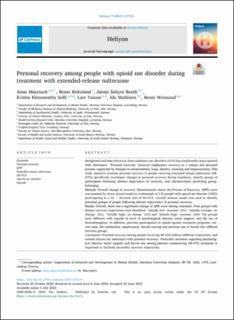| dc.contributor.author | Marciuch, Anne | |
| dc.contributor.author | Birkeland, Bente | |
| dc.contributor.author | Saltyte Benth, Jurate | |
| dc.contributor.author | Solli, Kristin Klemmetsby | |
| dc.contributor.author | Tanum, Lars Håkon Reiestad | |
| dc.contributor.author | Mathisen, Ida | |
| dc.contributor.author | Weimand, Bente | |
| dc.date.accessioned | 2023-10-24T09:43:33Z | |
| dc.date.available | 2023-10-24T09:43:33Z | |
| dc.date.created | 2023-07-24T11:58:22Z | |
| dc.date.issued | 2023 | |
| dc.identifier.citation | Marciuch, A., Birkeland, B., Benth, J. Š., Solli, K. K., Tanum, L., Mathisen, I. & Weimand, B. (2023). Personal recovery among people with opioid use disorder during treatment with extended-release naltrexone. Heliyon, 9(7), Artikkel e17516. | en_US |
| dc.identifier.issn | 2405-8440 | |
| dc.identifier.uri | https://hdl.handle.net/11250/3098316 | |
| dc.description.abstract | Background and aims: Recovery from substance use disorders (SUD) has traditionally been equated with abstinence. “Personal recovery” however emphasizes recovery as a unique and personal process, supported by changes in connectedness, hope, identity, meaning and empowerment. This study aimed to examine personal recovery in people receiving extended-release naltrexone (XR-NTX); specifically investigate changes in personal recovery during treatment, identify groups of participants following distinct trajectories of recovery, and characteristics predicting group-belonging.
Methods: Overall change in recovery (Questionnaire about the Process of Recovery, QPR) score was assessed by linear mixed model in a subsample of 135 people with opioid use disorder (OUD) participating in a 24 + 28-week trial of XR-NTX. Growth mixture model was used to identify potential groups of people following distinct trajectories of personal recovery.
Results: Overall, there was a significant change in QPR score during treatment. Four groups with distinct recovery trajectories were identified: “initially low– increase” (G1), “initially average– no change” (G2), “initially high– no change” (G3) and “initially high– increase” (G4). The groups were different with regards to level of psychological distress, social support, and the use of benzodiazepines. In addition, previous participation in opioid agonist treatment programs, current pain, life satisfaction, employment, heroin craving and previous use of heroin also differed between groups.
Conclusions: Personal recovery among people receiving XR-NTX follows different trajectories, and various factors are associated with personal recovery. Particular attention regarding psychological distress, social support and heroin use among patients commencing XR-NTX treatment is important to facilitate successful recovery trajectories. | en_US |
| dc.language.iso | eng | en_US |
| dc.rights | Navngivelse 4.0 Internasjonal | * |
| dc.rights.uri | http://creativecommons.org/licenses/by/4.0/deed.no | * |
| dc.title | Personal recovery among people with opioid use disorder during treatment with extended-release naltrexone | en_US |
| dc.type | Peer reviewed | en_US |
| dc.type | Journal article | en_US |
| dc.description.version | publishedVersion | en_US |
| dc.rights.holder | © 2023 The Authors. | en_US |
| dc.source.volume | 9 | en_US |
| dc.source.journal | Heliyon | en_US |
| dc.source.issue | 7 | en_US |
| dc.identifier.doi | https://doi.org/10.1016/j.heliyon.2023.e17516 | |
| dc.identifier.cristin | 2163206 | |
| dc.source.articlenumber | e17516 | en_US |
| cristin.ispublished | true | |
| cristin.fulltext | original | |
| cristin.qualitycode | 1 | |

